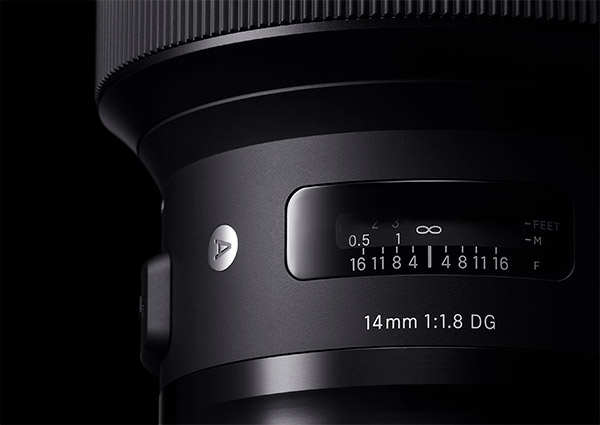Sigma announces four new lenses, including groundbreaking ultra-wide 14mm f/1.8
posted Tuesday, February 21, 2017 at 1:01 AM EDT

Sigma will be expanding its lineup of Global Vision Art and Contemporary lenses at the 2017 CP+ Camera + Photo Imaging Show in Tokyo, Japan. To get photographers ready for the massive show, Sigma has taken the wraps off four new lenses.
Before we look in detail at each of the lenses, there are a few features which are common among all four. All of the lenses will be available in Canon, Nikon and Sigma mounts. Further, they can all be adapted for Sony E-mount cameras through the use of Sigma's MC-11 mount converter and are also compatible with the Sigma USB dock. With the exception of the new 14mm lens, all of the Nikon versions of the announced lenses include an electromagnetic diaphragm. Finally, release and pricing information is not yet available for any of the newly-announced optics.
Let's take a look at each of the new lenses in detail.
Sigma 14mm f/1.8 DG HSM Art
The world's only ultra-wide-angle f/1.8 lens, the new full-frame 14mm f/1.8 DG HSM Art lens breaks new ground. This sixth full-frame prime Sigma Art lens will surely be of great interest to night sky photographers in particular, but is designed to appeal to anyone looking for a bright, fast ultra-wide angle optic.

To help ensure excellent optical performance, the Sigma 14mm f/1.8 DG HSM Art lens includes three "F" Low Dispersion (FLD) and four Super Low Dispersion (SLD) glass elements. Like the Sigma 12-24mm f/4 DG HSM Art lens, the first Sigma optic to include a large 80 millimeter diameter aspherical element, the 14mm f/1.8 includes one as well to minimize distortion. In total, the lens has 16 elements in 11 groups.

Additionally, the 14mm f/1.8 optic includes Sigma's latest autofocus technology and full-time manual override (depending on the mount type). The Japan-made lens weighs 41.3 ounces (1,170 grams) and has dimensions of (diameter x length) 3.8 x 5.0 inches (95.4 x 126 millimeters).
Sigma 135mm f/1.8 DG HSM Art

Sigma has announced a second prime lens, the Sigma 135mm f/1.8 DG HSM Art. The full-frame telephoto prime has been designed to not only offer the silky smooth bokeh and pleasing compression that 135mm lenses are known for, but Sigma has worked to ensure edge-to-edge sharpness and high resolving power.
This "portrait" prime sports a large hypersonic motor (HSM) and an optimized autofocus algorithm to provide ample performance for demanding professionals. This lens is the seventh 35mm full-frame prime lens in Sigma's Art line and features the same dust- and splash-proof construction photographers have come to expect from the Japanese company's premium line of lenses.
The lens includes 13 elements in 10 groups and has a minimum focus distance of 34.4 inches (87.5 centimeters). The lens has a 4.0 inch diameter and is 4.5 inches long (91.4 x 114.9 millimeters). The lens has nine diaphragm blades and a rounded diaphragm.

Sigma 24-70mm f/2.8 DG OS HSM Art
Moving now to familiar territory, Sigma is revamping their 24-70mm f/2.8 lens with the new Sigma 24-70mm f/2.8 DG HSM OS Art lens. The new version is Sigma's fourth 24-70mm f/2.8 lens. This latest lens employs a brand-new optical stabilization system and Sigma's latest autofocus technology. The workhorse lens is built to withstand difficult shooting conditions not only in terms of stabilization and focus, but the lens is also dust- and splash-proof and has rubber sealing around the mount. Further, the lens has a metal barrel. This durability will likely come with a hefty weight, but the final weight spec has not been shared. However, lens dimensions are available and are 3.5 x 4.2 inches (88 x 107.6 millimeters).

Optically, the lens is comprised of a total of 19 elements in 14 groups. There are three SLD elements and four aspherical elements. Additionally, the lens has been engineered to offer smooth, beautiful bokeh "with only slight spherical aberration." Like the new 14mm f/1.8 above, the 24-70mm f/2.8 DG HSM OS Art also includes Sigma's latest high-tech aspherical lenses.
Exact specifications for the new optical stabilizer (OS) technology are not yet available, but Sigma states that the new large hypersonic motor (HSM) "offers 1.3 times the torque of its predecessor and exceptionally stable performance even at lower speeds." For those who shoot at slow shutter speeds in highly variable conditions, you will be pleased to hear that the lens' external moving parts include thermally stable composite (TSC) materials, meaning that the lens is resistant to thermal expansion and contraction. This is very much a lens designed to deal with the hardships and rigors working pros put their lenses through.

Sigma 100-400mm f/5-6.3 DG OS HSM Contemporary
Sigma calls this new telephoto zoom lens a "light bazooka." The Sigma 100-400mm f/5-6.3 focuses on combining high-end performance and a long focal length without being big and heavy. The 100-400mm weighs 40.9 ounces (1,160 grams) and has dimensions of 3.4 x 7.2 inches (86.4 x 182.3 millimeters), which makes it a fairly compact lens for its class. To make the effective focal length even longer, this full-frame lens is compatible with Sigma's latest teleconverters as well.

The lens includes optical stabilization and hypersonic motor focus in addition to an updated AF algorithm and a focus limiter. The lens also has a push/pull zoom mechanism in addition to the traditional twist mechanism for enhanced usability. With a minimum shooting distance of 6.3 inches (160 centimeters), the lens can also serve as a macro lens, with a maximum magnification ratio of 1:3.8.

With four SLD glass elements, the overall optical construction includes 21 elements in 15 groups. The lens has 9 diaphragm blades and a rounded diaphragm. The entire lens is not dust- and splash-proof, but the mount is and it also includes rubber sealing. This new lens serves as an interesting alternative to the Sigma 150-600mm zoom lenses (Sports and Contemporary versions are available).